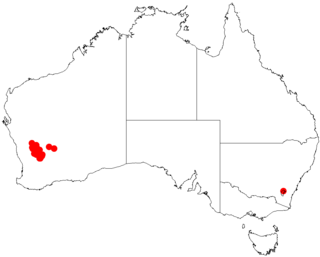
Acacia cultriformis, known as the knife-leaf wattle, dogtooth wattle, half-moon wattle or golden-glow wattle, is a perennial tree or shrub of the genus Acacia native to Australia. It is widely cultivated, and has been found to have naturalised in Asia, Africa, North America, New Zealand and South America. A. cultriformis grows to a height of about 4 m (13 ft) and has triangle-shaped phyllodes. The yellow flowers appear from August to November in its natural range. Its attractive foliage and bright flowers make it a popular garden plant.

Acacia myrtifolia, known colloquially as myrtle wattle, red stem wattle or red-stemmed wattle, is a species of Acacia native to coastal areas of southern and eastern Australia.

Acacia concurrens, commonly known as curracabah or black wattle, is a shrub native to Queensland in eastern Australia.

Acacia buxifolia, commonly known as box-leaf wattle, is shrub species that is endemic to eastern Australia.

Acacia caesiella, commonly known as tableland wattle, bluebush wattle or blue bush, is a shrub or small tree that is endemic to eastern Australia.

Acacia cana, or commonly named as boree or the cabbage-tree wattle or broad-leaved nealie, is part of the family Fabaceae and sub-family Mimosoideae. It is a dense shrub- tree that can grow to 6 metres (20 ft) high and is a perennial plant meaning it has long life span and doesn’t necessary produce a high amount of seed. The cabbage-tree wattle heavily flowers from August till October and relies on animals and insects for pollination and dispersal of seeds. This least concern acacia species is found in the western plains of New South Wales and Central Queensland the habitats of these areas are found to be sandy soils and gibber plains.

Acacia argyraea is a shrub belonging to the genus Acacia and the subgenus Juliflorae that is endemic to tropical parts of northern Australia.

Acacia dictyophleba, also known as the sandhill wattle, waxy wattle and feather veined wattle, is a shrub belonging to the genus Acacia and the subgenus Phyllodineae. The Nyangumarta peoples know the plant as Langkur or Lungkun and the Thalanyji know it as Jabandi.

Acacia merrickiae is a shrub belonging to the genus Acacia and the subgenus Phyllodineae that is endemic to a small area of south western Australia.

Acacia obtecta is a shrub of the genus Acacia and the subgenus Plurinerves that is endemic to a small area in south western Australia.

Acacia betchei, commonly known as red-tip wattle, is a shrub belonging to the genus Acacia and the subgenus Phyllodineae endemic to eastern Australia.

Acacia conferta, commonly known as crowded-leaf wattle, is a shrub belonging to the genus Acacia and the subgenus Phyllodineae that is endemic to eastern Australia.

Acacia piligera, also known as grub-pod wattle, is a tree or shrub belonging to the genus Acacia and the subgenus Phyllodineae native to eastern Australia.

Acacia pilligaensis, commonly known as Pillaga wattle or pinbush wattle, is a tree or shrub belonging to the genus Acacia and the subgenus Phyllodineae native to eastern Australia.

Acacia kybeanensis, commonly known as kybean wattle or kybeyan wattle, is a shrub of the genus Acacia and the subgenus Phyllodineae that is endemic to south eastern Australia.

Acacia linearifolia, commonly known as stringybark wattle or narrow-leaved wattle, is a shrub or tree of the genus Acacia and the subgenus Phyllodineae that is endemic to eastern Australia.

Acacia tropica is a shrub or small tree native to tropical areas northern Australia.

Acacia curranii, also known as curly-bark wattle, is a shrub belonging to the genus Acacia and the subgenus Juliflorae that is native to north eastern Australia. It is listed as vulnerable under the Environment Protection and Biodiversity Conservation Act 1999.

Acacia petraea, commonly known as lancewood, is a shrub or tree belonging to the genus Acacia and the subgenus Juliflorae that is native to north eastern Australia.

Acacia melvillei, commonly known as yarran, is a shrub of the genus Acacia and the subgenus Plurinerves that is endemic to south eastern Australia.




















